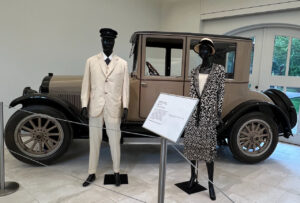
A 1938 Packard Twelve Convertible similar to one used by Gus Greenlee, owner of the Negro League’s Pittsburgh Crawfords. Photo by John Griswold
The Frick Pittsburgh—not to be confused with the Frick Fine Arts Building at the University of Pittsburgh, the Frick Building in Pittsburgh, or The Frick Collection or the Frick Art Reference Library in New York City—has a special exhibit now called Pittsburgh and the Great Migration: Black Mobility and the Automobile, which ends February 4.
In the American South racial violence and disenfranchisement made job openings in Northern factories short on labor seem like the possibility of escape to “the promised land.” But the expense of public transport, the dangers and inconveniences of segregated waiting rooms and modes of travel, and the problems of finding food to eat when restaurants and stores often refused to serve Black travelers, made the self-guided and -paced car vital. It represented freedom.
Yet, as the exhibit shows, the costs of cars were not the same for Black and White, from the start to now. Loans were harder to get for Black owners, and insurance was higher. Interstate highways that allowed rapid movement by car often destroyed the integrity of Black neighborhoods, not White, and deadly interactions between police and Black drivers are frequently reported.

A 1941 Pontiac Super Streamliner Torpedo 6 Sedan Coupe of the type used by the Owl Cab company.Photo by John Griswold
The Frick exhibit is a dozen beautiful old cars in a single room, with signage to set context both nationally and in Pittsburgh, where the Hill District was a vibrant Black neighborhood. When White-owned businesses refused to service The Hill, Black companies bought cars and offered cab and ambulance services of their own.
The room next door has several (older) vehicles on display from the museum’s permanent auto collection.
In the Great Migration exhibit, a Black mannequin wears one of Frick’s outfits, a docent told us. This seems gutsily pointed for an institution funded by Frick’s fortune. He was not only one of the richest men in America, but his legacy includes abusive roles in the Johnstown Flood and the Homestead Strike.

The male mannequin styles one of Henry Clay Frick’s yachting outfits. The car is a 1922 Lincoln Model L. Photo by John Griswold
“Great Migration settlers would go on to work in steel mills, railroads, and other industries built by powerful tycoons like Frick Pittsburgh’s namesake, Henry Clay Frick, and his family, who profited off the labor of exploited workers,” the Pittsburgh City Paper says. “Often, Black workers were relegated to the most dangerous, lowest paying jobs.”
There are similarly-themed exhibits at the 820 Gallery in Pittsburgh (a virtual reality experience called Traveling While Black, ends September 24) and the Holocaust Museum Houston (The Negro Motorist Green Book, through November 26).
The Green Book was a publication intended to help Black drivers know where to stop to refuel, rest, or eat along the length of a journey through unfamiliar landscapes. The Green Book exhibit is produced by the Smithsonian Institution Traveling Exhibition Service, which is sending it around the country; it just left Pittsburgh.
